belt Hyundai Santa Fe 2009 - RHD (UK, Australia) Owner's Guide
[x] Cancel search | Manufacturer: HYUNDAI, Model Year: 2009, Model line: Santa Fe, Model: Hyundai Santa Fe 2009Pages: 269, PDF Size: 9.78 MB
Page 154 of 269
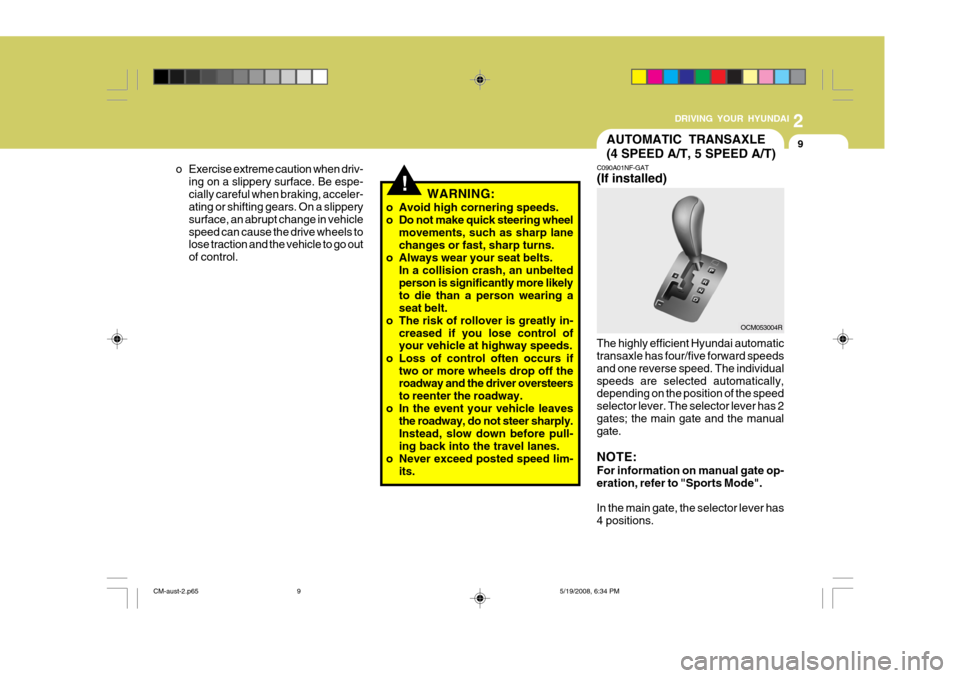
2
DRIVING YOUR HYUNDAI
9
!
o Exercise extreme caution when driv-
ing on a slippery surface. Be espe- cially careful when braking, acceler- ating or shifting gears. On a slippery surface, an abrupt change in vehiclespeed can cause the drive wheels to lose traction and the vehicle to go out of control. WARNING:
o Avoid high cornering speeds.
o Do not make quick steering wheel movements, such as sharp lanechanges or fast, sharp turns.
o Always wear your seat belts.
In a collision crash, an unbelted person is significantly more likely to die than a person wearing aseat belt.
o The risk of rollover is greatly in- creased if you lose control of your vehicle at highway speeds.
o Loss of control often occurs if two or more wheels drop off theroadway and the driver oversteers to reenter the roadway.
o In the event your vehicle leaves
the roadway, do not steer sharply.Instead, slow down before pull- ing back into the travel lanes.
o Never exceed posted speed lim- its.
AUTOMATIC TRANSAXLE (4 SPEED A/T, 5 SPEED A/T)
C090A01NF-GAT (If installed)
The highly efficient Hyundai automatic transaxle has four/five forward speeds and one reverse speed. The individualspeeds are selected automatically, depending on the position of the speed selector lever. The selector lever has 2gates; the main gate and the manual gate. NOTE: For information on manual gate op- eration, refer to "Sports Mode". In the main gate, the selector lever has 4 positions.
OCM053004R
CM-aust-2.p65 5/19/2008, 6:34 PM
9
Page 158 of 269
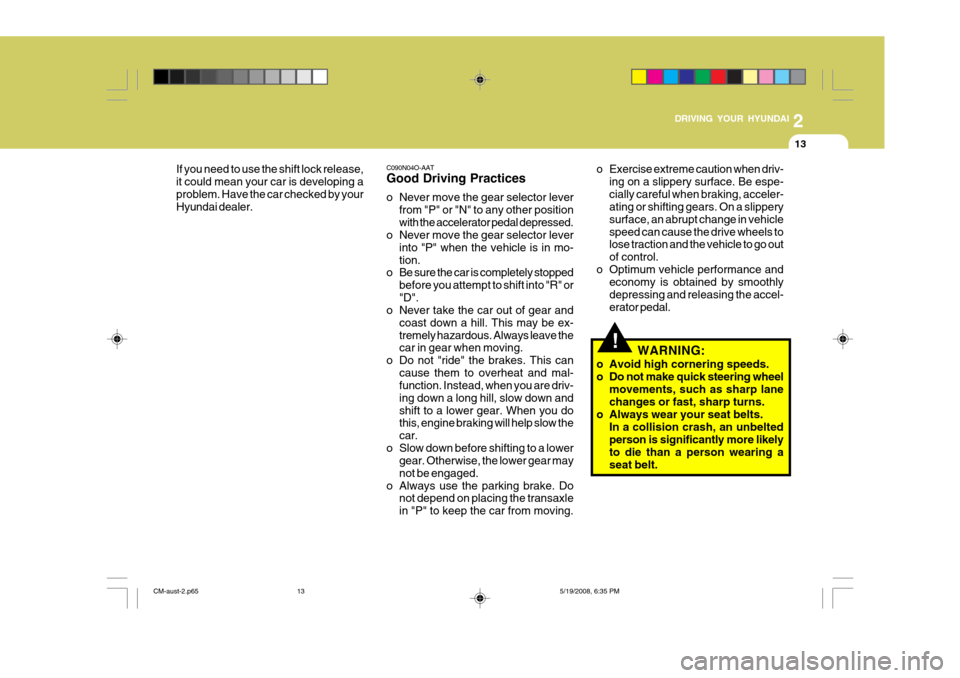
2
DRIVING YOUR HYUNDAI
13
!
C090N04O-AAT Good Driving Practices
o Never move the gear selector lever
from "P" or "N" to any other position with the accelerator pedal depressed.
o Never move the gear selector lever
into "P" when the vehicle is in mo-tion.
o Be sure the car is completely stopped
before you attempt to shift into "R" or"D".
o Never take the car out of gear and
coast down a hill. This may be ex-tremely hazardous. Always leave the car in gear when moving.
o Do not "ride" the brakes. This can cause them to overheat and mal-function. Instead, when you are driv- ing down a long hill, slow down andshift to a lower gear. When you do this, engine braking will help slow the car.
o Slow down before shifting to a lower gear. Otherwise, the lower gear maynot be engaged.
o Always use the parking brake. Do not depend on placing the transaxlein "P" to keep the car from moving.
If you need to use the shift lock release,it could mean your car is developing aproblem. Have the car checked by your Hyundai dealer.
o Exercise extreme caution when driv-
ing on a slippery surface. Be espe- cially careful when braking, acceler- ating or shifting gears. On a slippery surface, an abrupt change in vehiclespeed can cause the drive wheels to lose traction and the vehicle to go out of control.
o Optimum vehicle performance and economy is obtained by smoothlydepressing and releasing the accel-erator pedal.
WARNING:
o Avoid high cornering speeds.
o Do not make quick steering wheel movements, such as sharp lane changes or fast, sharp turns.
o Always wear your seat belts. In a collision crash, an unbelted person is significantly more likelyto die than a person wearing a seat belt.
CM-aust-2.p65 5/19/2008, 6:35 PM
13
Page 161 of 269
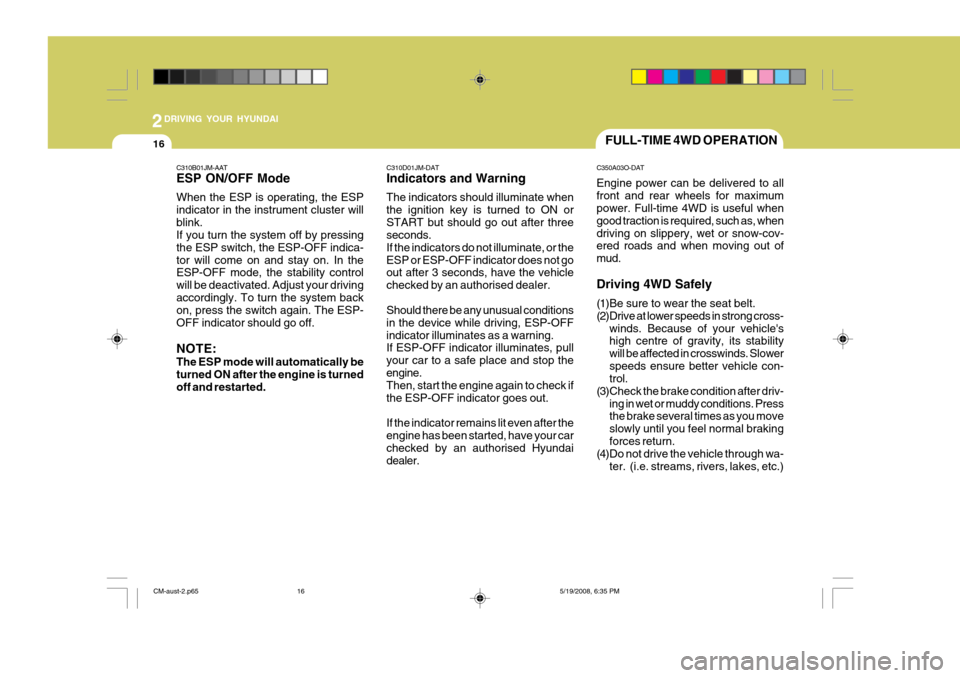
2DRIVING YOUR HYUNDAI
16FULL-TIME 4WD OPERATION
C350A03O-DAT Engine power can be delivered to all front and rear wheels for maximum power. Full-time 4WD is useful when good traction is required, such as, whendriving on slippery, wet or snow-cov- ered roads and when moving out of mud. Driving 4WD Safely
(1)Be sure to wear the seat belt.
(2)Drive at lower speeds in strong cross- winds. Because of your vehicle's high centre of gravity, its stability will be affected in crosswinds. Slowerspeeds ensure better vehicle con- trol.
(3)Check the brake condition after driv- ing in wet or muddy conditions. Pressthe brake several times as you move slowly until you feel normal brakingforces return.
(4)Do not drive the vehicle through wa-
ter. (i.e. streams, rivers, lakes, etc.)
C310B01JM-AAT ESP ON/OFF Mode When the ESP is operating, the ESP indicator in the instrument cluster willblink. If you turn the system off by pressing the ESP switch, the ESP-OFF indica-tor will come on and stay on. In the ESP-OFF mode, the stability control will be deactivated. Adjust your drivingaccordingly. To turn the system back on, press the switch again. The ESP- OFF indicator should go off. NOTE: The ESP mode will automatically be turned ON after the engine is turnedoff and restarted.
C310D01JM-DAT Indicators and Warning The indicators should illuminate when the ignition key is turned to ON orSTART but should go out after three seconds. If the indicators do not illuminate, or theESP or ESP-OFF indicator does not go out after 3 seconds, have the vehicle checked by an authorised dealer. Should there be any unusual conditions in the device while driving, ESP-OFFindicator illuminates as a warning. If ESP-OFF indicator illuminates, pull your car to a safe place and stop theengine. Then, start the engine again to check if the ESP-OFF indicator goes out. If the indicator remains lit even after the engine has been started, have your carchecked by an authorised Hyundai dealer.
CM-aust-2.p65
5/19/2008, 6:35 PM
16
Page 164 of 269
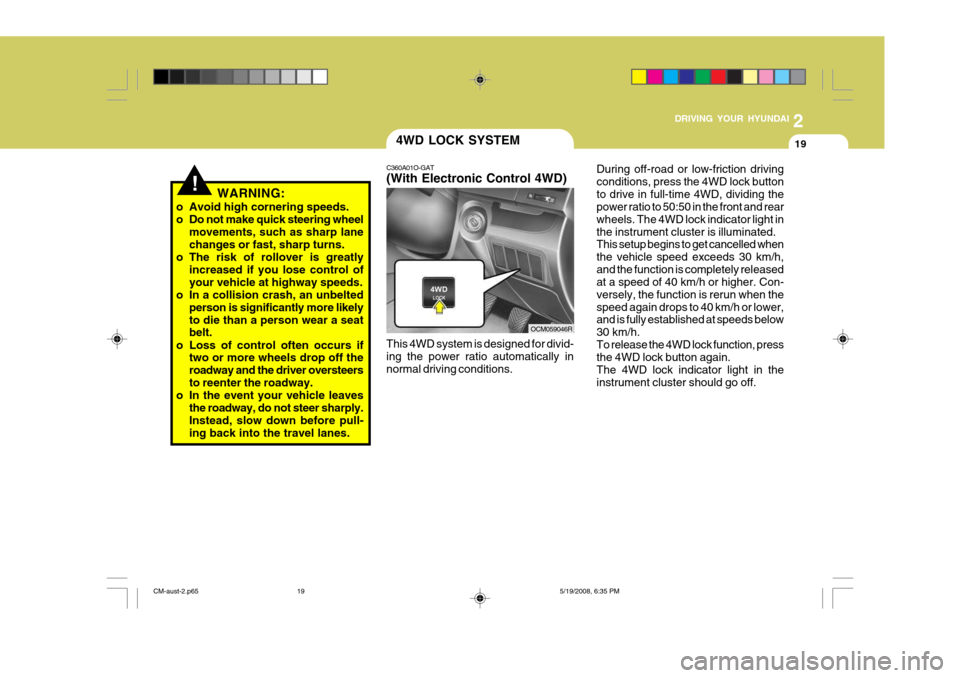
2
DRIVING YOUR HYUNDAI
19
!
4WD LOCK SYSTEM
C360A01O-GAT (With Electronic Control 4WD) This 4WD system is designed for divid- ing the power ratio automatically innormal driving conditions. During off-road or low-friction drivingconditions, press the 4WD lock buttonto drive in full-time 4WD, dividing the power ratio to 50:50 in the front and rear wheels. The 4WD lock indicator light inthe instrument cluster is illuminated. This setup begins to get cancelled when the vehicle speed exceeds 30 km/h,and the function is completely released at a speed of 40 km/h or higher. Con- versely, the function is rerun when thespeed again drops to 40 km/h or lower, and is fully established at speeds below 30 km/h.To release the 4WD lock function, press the 4WD lock button again. The 4WD lock indicator light in theinstrument cluster should go off.
OCM059046R
WARNING:
o Avoid high cornering speeds.
o Do not make quick steering wheel movements, such as sharp lane changes or fast, sharp turns.
o The risk of rollover is greatly increased if you lose control ofyour vehicle at highway speeds.
o In a collision crash, an unbelted person is significantly more likelyto die than a person wear a seat belt.
o Loss of control often occurs if two or more wheels drop off the roadway and the driver oversteersto reenter the roadway.
o In the event your vehicle leaves the roadway, do not steer sharply. Instead, slow down before pull- ing back into the travel lanes.
CM-aust-2.p65 5/19/2008, 6:35 PM
19
Page 170 of 269
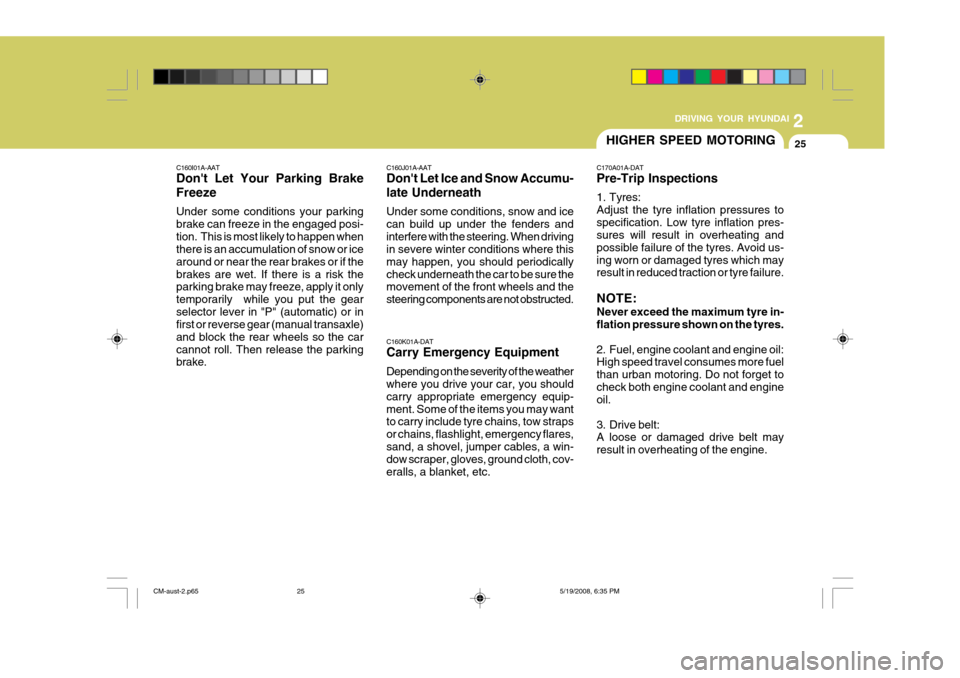
2
DRIVING YOUR HYUNDAI
25
C160J01A-AAT Don't Let Ice and Snow Accumu- late Underneath Under some conditions, snow and ice can build up under the fenders andinterfere with the steering. When driving in severe winter conditions where this may happen, you should periodicallycheck underneath the car to be sure the movement of the front wheels and the steering components are not obstructed. C160K01A-DAT Carry Emergency Equipment Depending on the severity of the weather where you drive your car, you should carry appropriate emergency equip-ment. Some of the items you may want to carry include tyre chains, tow straps or chains, flashlight, emergency flares,sand, a shovel, jumper cables, a win- dow scraper, gloves, ground cloth, cov- eralls, a blanket, etc.HIGHER SPEED MOTORING
C170A01A-DAT Pre-Trip Inspections
1. Tyres: Adjust the tyre inflation pressures tospecification. Low tyre inflation pres- sures will result in overheating and possible failure of the tyres. Avoid us-ing worn or damaged tyres which may result in reduced traction or tyre failure. NOTE: Never exceed the maximum tyre in- flation pressure shown on the tyres.
2. Fuel, engine coolant and engine oil: High speed travel consumes more fuel than urban motoring. Do not forget tocheck both engine coolant and engine oil.
3. Drive belt: A loose or damaged drive belt may result in overheating of the engine.
C160I01A-AAT Don't Let Your Parking Brake Freeze Under some conditions your parking brake can freeze in the engaged posi-tion. This is most likely to happen when there is an accumulation of snow or ice around or near the rear brakes or if thebrakes are wet. If there is a risk the parking brake may freeze, apply it only temporarily while you put the gearselector lever in "P" (automatic) or in first or reverse gear (manual transaxle) and block the rear wheels so the carcannot roll. Then release the parking brake.
CM-aust-2.p65
5/19/2008, 6:35 PM
25
Page 179 of 269
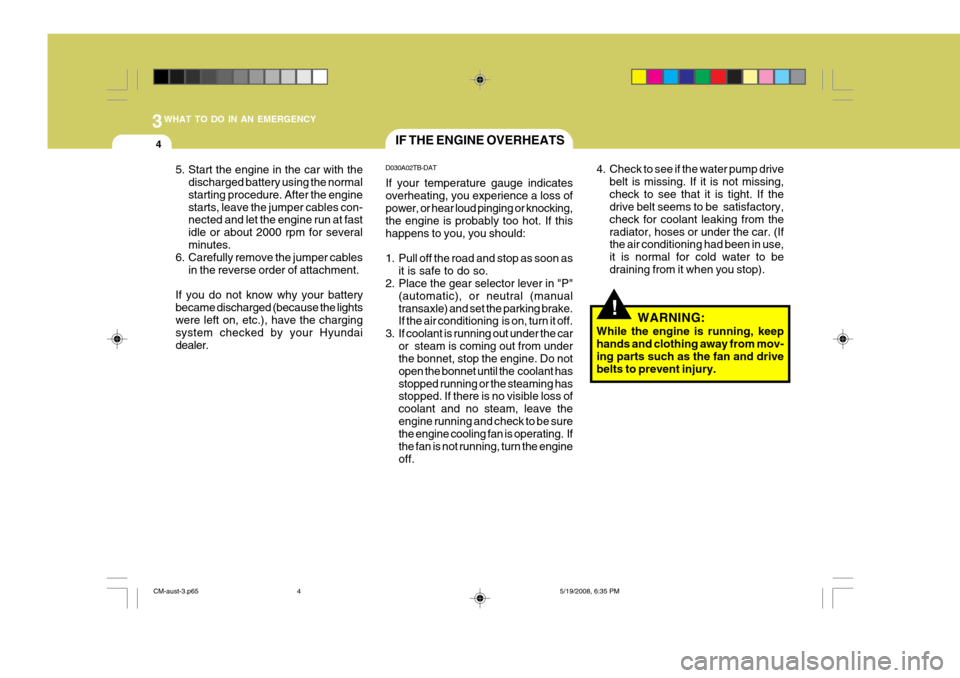
3WHAT TO DO IN AN EMERGENCY
4
!
IF THE ENGINE OVERHEATS
4. Check to see if the water pump drivebelt is missing. If it is not missing, check to see that it is tight. If the drive belt seems to be satisfactory, check for coolant leaking from theradiator, hoses or under the car. (If the air conditioning had been in use, it is normal for cold water to bedraining from it when you stop).
D030A02TB-DAT If your temperature gauge indicates overheating, you experience a loss of power, or hear loud pinging or knocking, the engine is probably too hot. If thishappens to you, you should:
1. Pull off the road and stop as soon as
it is safe to do so.
2. Place the gear selector lever in "P"
(automatic), or neutral (manual transaxle) and set the parking brake. If the air conditioning is on, turn it off.
3. If coolant is running out under the car or steam is coming out from underthe bonnet, stop the engine. Do not open the bonnet until the coolant hasstopped running or the steaming has stopped. If there is no visible loss of coolant and no steam, leave theengine running and check to be sure the engine cooling fan is operating. If the fan is not running, turn the engineoff. WARNING:
While the engine is running, keephands and clothing away from mov-ing parts such as the fan and drive belts to prevent injury.
5. Start the engine in the car with the
discharged battery using the normal starting procedure. After the enginestarts, leave the jumper cables con- nected and let the engine run at fast idle or about 2000 rpm for severalminutes.
6. Carefully remove the jumper cables
in the reverse order of attachment.
If you do not know why your batterybecame discharged (because the lightswere left on, etc.), have the charging system checked by your Hyundai dealer.
CM-aust-3.p65 5/19/2008, 6:35 PM
4
Page 180 of 269
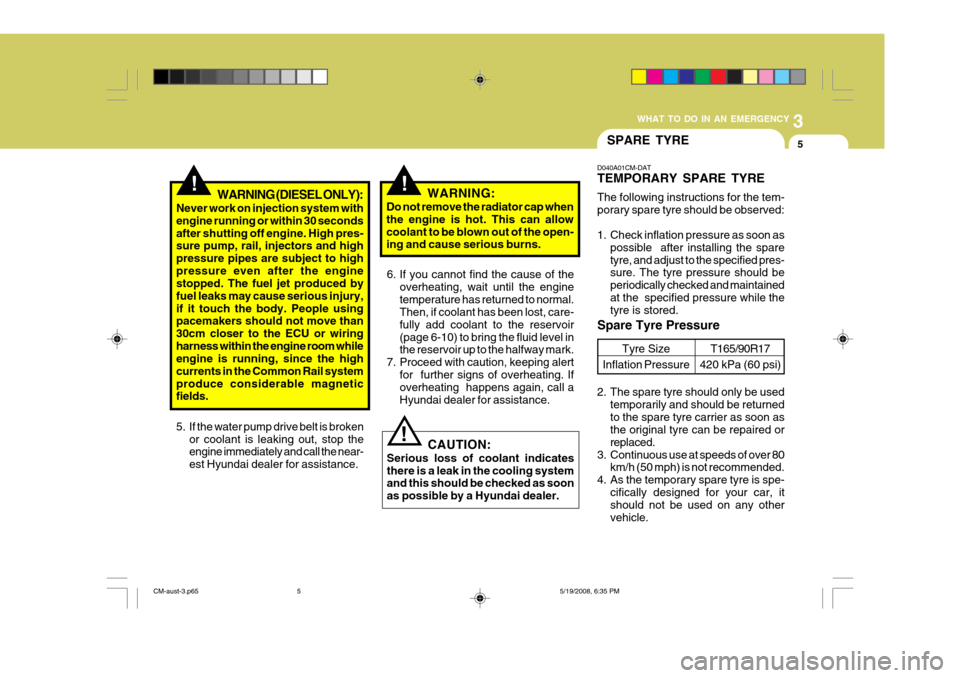
3
WHAT TO DO IN AN EMERGENCY
5
!
5. If the water pump drive belt is broken
or coolant is leaking out, stop the engine immediately and call the near- est Hyundai dealer for assistance. WARNING:
Do not remove the radiator cap whenthe engine is hot. This can allowcoolant to be blown out of the open- ing and cause serious burns.
!WARNING (DIESEL ONLY):
Never work on injection system with engine running or within 30 secondsafter shutting off engine. High pres- sure pump, rail, injectors and high pressure pipes are subject to highpressure even after the engine stopped. The fuel jet produced by fuel leaks may cause serious injury,if it touch the body. People using pacemakers should not move than 30cm closer to the ECU or wiringharness within the engine room while engine is running, since the high currents in the Common Rail systemproduce considerable magnetic fields. 6. If you cannot find the cause of the
overheating, wait until the engine temperature has returned to normal. Then, if coolant has been lost, care- fully add coolant to the reservoir(page 6-10) to bring the fluid level in the reservoir up to the halfway mark.
7. Proceed with caution, keeping alert for further signs of overheating. Ifoverheating happens again, call a Hyundai dealer for assistance.
CAUTION:
Serious loss of coolant indicatesthere is a leak in the cooling system and this should be checked as soon as possible by a Hyundai dealer.
!
SPARE TYRE
D040A01CM-DAT TEMPORARY SPARE TYRE The following instructions for the tem- porary spare tyre should be observed:
1. Check inflation pressure as soon as possible after installing the spare tyre, and adjust to the specified pres- sure. The tyre pressure should be periodically checked and maintainedat the specified pressure while the tyre is stored.
Spare Tyre Pressure
Tyre Size
Inflation PressureT165/90R17
420 kPa (60 psi)
2. The spare tyre should only be used temporarily and should be returned to the spare tyre carrier as soon as the original tyre can be repaired or replaced.
3. Continuous use at speeds of over 80 km/h (50 mph) is not recommended.
4. As the temporary spare tyre is spe-
cifically designed for your car, it should not be used on any other vehicle.
CM-aust-3.p65 5/19/2008, 6:35 PM
5
Page 196 of 269
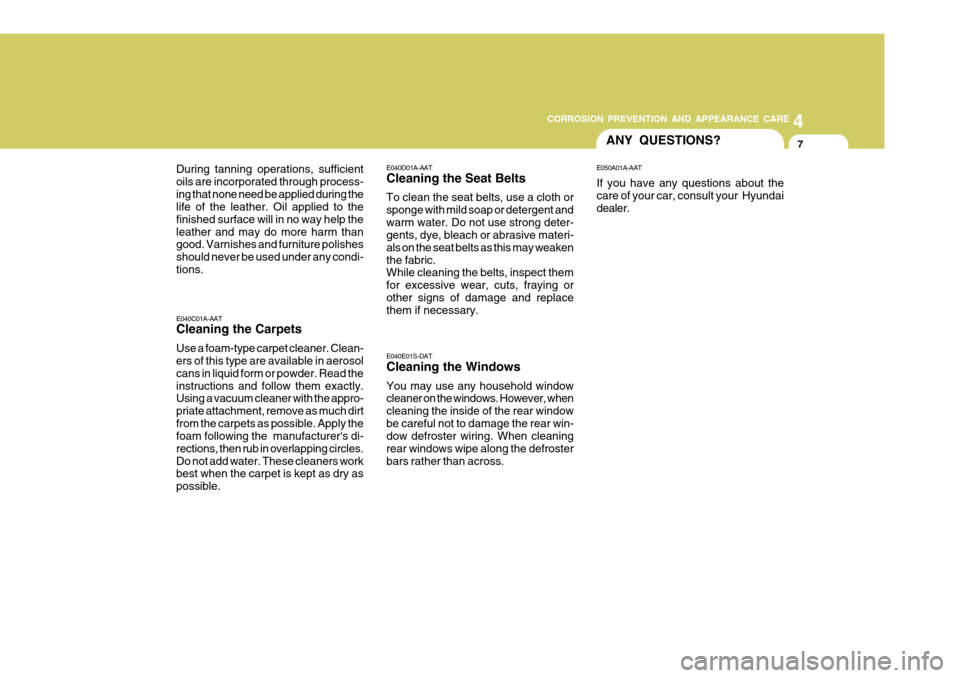
4
CORROSION PREVENTION AND APPEARANCE CARE
7
E040E01S-DAT Cleaning the Windows You may use any household window cleaner on the windows. However, when cleaning the inside of the rear windowbe careful not to damage the rear win- dow defroster wiring. When cleaning rear windows wipe along the defrosterbars rather than across.
E040D01A-AAT Cleaning the Seat Belts To clean the seat belts, use a cloth or sponge with mild soap or detergent andwarm water. Do not use strong deter- gents, dye, bleach or abrasive materi- als on the seat belts as this may weakenthe fabric. While cleaning the belts, inspect them for excessive wear, cuts, fraying orother signs of damage and replace them if necessary.
E040C01A-AAT Cleaning the Carpets Use a foam-type carpet cleaner. Clean- ers of this type are available in aerosol cans in liquid form or powder. Read theinstructions and follow them exactly. Using a vacuum cleaner with the appro- priate attachment, remove as much dirtfrom the carpets as possible. Apply the foam following the manufacturer's di- rections, then rub in overlapping circles.Do not add water. These cleaners work best when the carpet is kept as dry as possible.
During tanning operations, sufficientoils are incorporated through process-ing that none need be applied during the life of the leather. Oil applied to the finished surface will in no way help theleather and may do more harm than good. Varnishes and furniture polishes should never be used under any condi-tions.
E050A01A-AAT If you have any questions about the care of your car, consult your Hyundai dealer.
ANY QUESTIONS?
Page 200 of 269
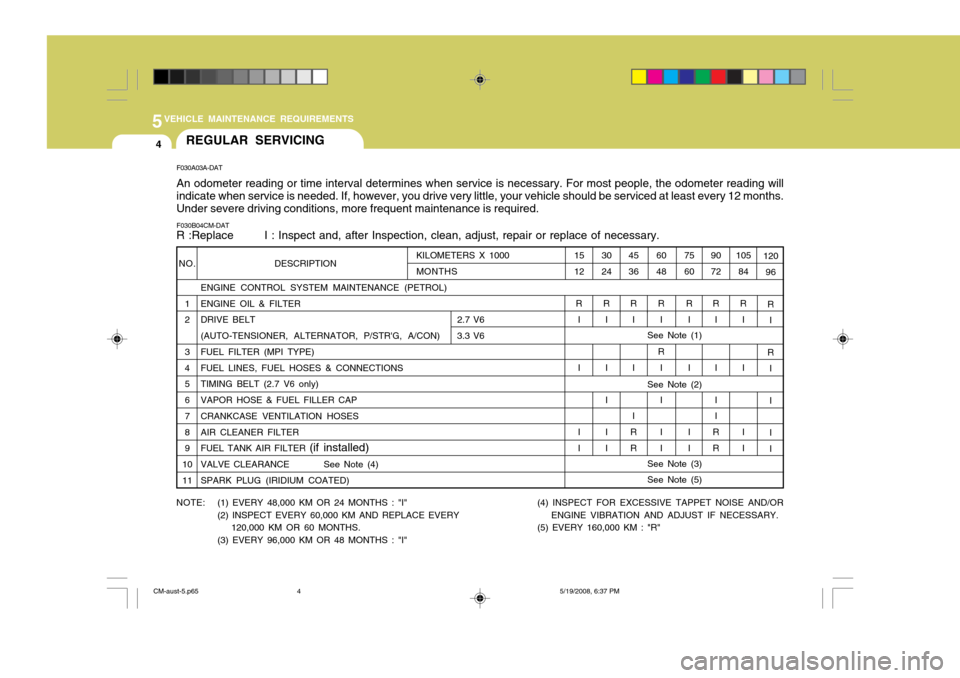
5VEHICLE MAINTENANCE REQUIREMENTS
4REGULAR SERVICING
F030A03A-DAT An odometer reading or time interval determines when service is necessary. For most people, the odometer reading will indicate when service is needed. If, however, you drive very little, your vehicle should be serviced at least every 12 months. Under severe driving conditions, more frequent maintenance is required.
See Note (3) See Note (5)
NO.
12 3 4 5 6 7 8 9
1011
F030B04CM-DAT R :Replace I : Inspect and, after Inspection, clean, adjust, repair or replace of necessary.
105
84
R I I I I 120
96
R I
R I II I
9072
R I I I I
RR
75 60
R I I I I
60 48
R I
R I II I
45 36
R I I I
R R
30 24
R I I II I
15 12
R I I I I
KILOMETERS X 1000 MONTHS DESCRIPTION ENGINE CONTROL SYSTEM MAINTENANCE (PETROL) ENGINE OIL & FILTER
DRIVE BELT
2.7 V6
(AUTO-TENSIONER, ALTERNATOR, P/STR'G, A/CON) 3.3 V6FUEL FILTER (MPI TYPE) FUEL LINES, FUEL HOSES & CONNECTIONS TIMING BELT (2.7 V6 only) VAPOR HOSE & FUEL FILLER CAP CRANKCASE VENTILATION HOSES AIR CLEANER FILTER FUEL TANK AIR FILTER (if installed)
VALVE CLEARANCE See Note (4)SPARK PLUG (IRIDIUM COATED)
NOTE: (1) EVERY 48,000 KM OR 24 MONTHS : "I" (2) INSPECT EVERY 60,000 KM AND REPLACE EVERY
120,000 KM OR 60 MONTHS.
(3) EVERY 96,000 KM OR 48 MONTHS : "I"
See Note (2)
See Note (1)
(4) INSPECT FOR EXCESSIVE TAPPET NOISE AND/OR ENGINE VIBRATION AND ADJUST IF NECESSARY.
(5) EVERY 160,000 KM : "R"
CM-aust-5.p65 5/19/2008, 6:37 PM
4
Page 201 of 269
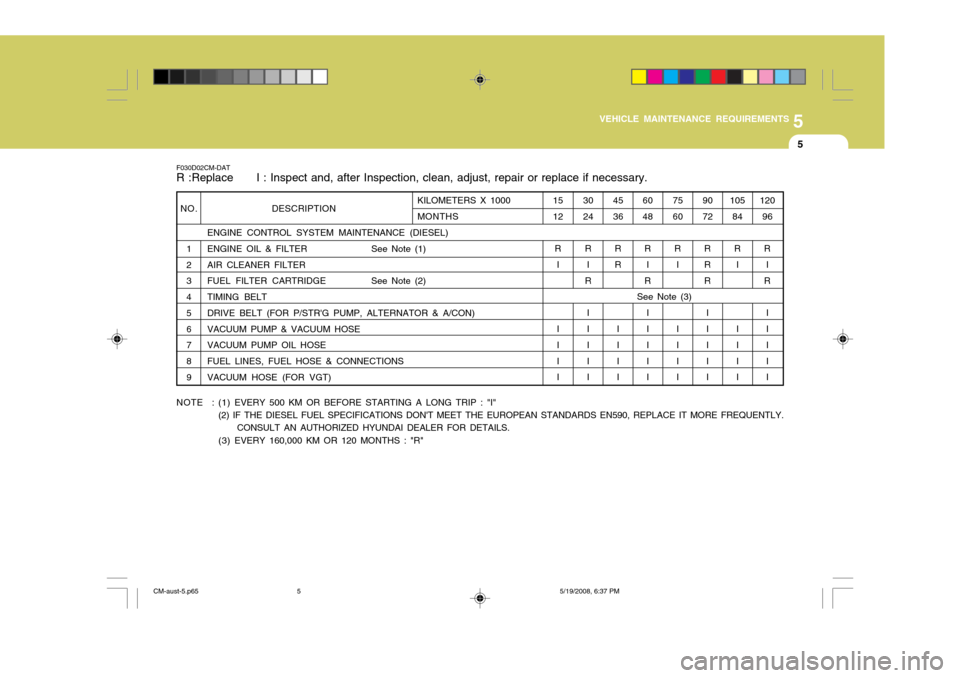
5
VEHICLE MAINTENANCE REQUIREMENTS
5
DESCRIPTION
ENGINE CONTROL SYSTEM MAINTENANCE (DIESEL)
ENGINE OIL & FILTER See Note (1) AIR CLEANER FILTER
FUEL FILTER CARTRIDGE See Note (2) TIMING BELT DRIVE BELT (FOR P/STR'G PUMP, ALTERNATOR & A/CON) VACUUM PUMP & VACUUM HOSE VACUUM PUMP OIL HOSE FUEL LINES, FUEL HOSE & CONNECTIONS VACUUM HOSE (FOR VGT)
F030D02CM-DAT R :Replace I : Inspect and, after Inspection, clean, adjust, repair or replace if necessary.
NOTE : (1) EVERY 500 KM OR BEFORE STARTING A LONG TRIP : "I"
(2) IF THE DIESEL FUEL SPECIFICATIONS DON'T MEET THE EUROPEAN STANDARDS EN590, REPLACE IT MORE FREQUENTLY.
CONSULT AN AUTHORIZED HYUNDAI DEALER FOR DETAILS.
(3) EVERY 160,000 KM OR 120 MONTHS : "R"
120
96
R I
R
I I I I I
105
84
R I I I I I
9072
R R R I I I I I
7560
R I I I I I
6048
R I
R
I I I I I
4536
R R
I I I I
3024
R I
R
I I I I I
1512
R I I I I I
KILOMETERS X 1000MONTHSNO.
1 2 3 4 5 6 7 8 9
See Note (3)
CM-aust-5.p65 5/19/2008, 6:37 PM
5